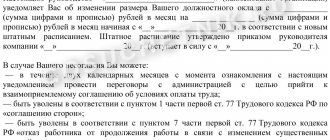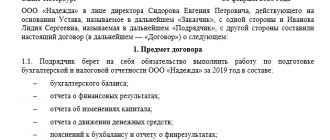Absenteeism, unfortunately, is a fairly common occurrence not only in educational institutions; it also happens in the workplace. Employers who are dissatisfied with the unjustified absence of an employee may refuse to continue to cooperate with the truant, dismissing him under the relevant article of the Labor Code. At the same time, in order for such a dismissal not to be challenged in the future, it is necessary to strictly comply with the administrative “regulations”, and most importantly, to correctly qualify absenteeism from the point of view of labor legislation.
Question: Is it legal to dismiss an employee who does not go to work during a period of downtime if the employer’s LNA does not indicate the employee’s right not to go to work during such a period? View answer
The absentee does not agree with the dismissal: can it be challenged?
Absenteeism is a violation so serious that even a single proven case is sufficient by law to dismiss the offender. After all, sometimes employee absenteeism can be fraught with serious unpleasant or even fatal consequences for the entire activity of the enterprise.
However, when dismissing on the basis of absenteeism, the employer must strive to avoid mistakes that could lead to challenging the dismissal in court. If the decision is positive, the plaintiff’s dismissal for absenteeism will be considered illegal.
Question: The employee presented the employer with a sick leave certificate for payment. When checking the authenticity of the sick leave certificate presented, it turned out that it was fake. Is it possible to fire an employee for absenteeism in this case? View answer
This entails the reinstatement of the dismissed person in his previous position with payment of salary for the entire period, from unfair dismissal to the end of the trial, and in some cases, compensation for moral damage. This, unfortunately for the employer, is possible if:
- the reason for dismissal for absenteeism was a fact that is not absenteeism as defined by legislative documents;
- the algorithm of actions during the dismissal procedure due to absenteeism was violated;
- There were errors and inaccuracies in the preparation of relevant documents.
Let's consider how to maintain accuracy in each of these points so that everything is flawless from the point of view of current legislation.
Question: An employee submitted a written application for three days of leave at his own expense in connection with the death and funeral of his brother. The General Director, who accepted the application, verbally authorized the granting of leave. However, the application does not contain a visa for the general director, and no order was issued to grant leave. The employee did not show up for work. Is an employee subject to dismissal for absenteeism? View answer
Example of a completed form
When filling out the T-8 form, it is recommended to use an example. This will simplify the procedure for entering information and reduce time costs.
Thus, an order of dismissal for absenteeism can be drawn up on a standard T-8 form or letterhead. The document must be drawn up in compliance with the standards and rules of office work.
The order is issued in a single copy. The employee is introduced to him against his signature. Then the document is transferred to the enterprise archive for storage. When writing an order, it is recommended to use an example. This will simplify and speed up the procedure for issuing an order.
Truancy through the eyes of the law
The Labor Code of the Russian Federation in subparagraph a 6 of paragraph 1 of article 81 clearly defines this disciplinary violation and describes the possible actions of the employer provided for in legislative acts.
Question: Is it possible to fire an employee for absenteeism who did not notify the organization of his absence from work in connection with participation in elections as a member of the election commission, if the election commission received a proposal from the employee 3 days after the elections? View answer
According to the Labor Code, absenteeism is an employee being outside the workplace during the working day or shift (regardless of its duration) or being absent during working hours for more than 4 hours in a row or cumulatively for a shift for reasons considered disrespectful by the employer.
NOTE! Exactly 4 hours of absence is not absenteeism! Lunch break is not included in the time calculation.
Question: Can an organization fire an employee for absenteeism if, when transferred to remote work, but in the absence of a written agreement for the transfer, the employee does not appear in the office, considering the terms of the employment contract to be changed? View answer
Order of dismissal for absenteeism: sample 2021
At the moment of signing an employment contract, each employee assumes obligations to fulfill the employer’s requirements specified in the document. First of all, any manager monitors the observance of labor discipline by his subordinates, on which the quality and volume of services provided directly depends. Missing a work shift is a gross violation of labor regulations and is grounds for termination of cooperation with the person. In this article, we will consider the procedure for drawing up an Order of Dismissal for Absenteeism, the sample and rules for its preparation, as well as the types of violations that can be classified by a manager in a similar way.
The procedure for canceling the employment relationship between an employer and a subordinate must be documented. The main document that expresses management’s desire to terminate cooperation with an unscrupulous person is an Order containing the following information:
- Name of the employing organization;
- Individual document number, which is assigned to it according to the internal registration journal;
- Document title: “Dismissal Order”;
- The text part, which contains information about the manager’s desire to dismiss the employee for an act committed under a certain article of labor legislation. Indication of a link to an article of the Labor Code of the Russian Federation is mandatory when drawing up this administrative document;
- The basis that became the reason for issuing the Order is indicated; it may be a drawn up Act on absenteeism by an employee of his work shift;
- Signatures of the head of the company and the violator, who will soon be fired.
Expert opinion
Lebedev Sergey Fedorovich
Practitioner lawyer with 7 years of experience. Specialization: civil law. Extensive experience in defense in court.
As a rule, the Order is drawn up by specialists of the personnel department in the T-8 form established by the legislator. However, if the company has developed its own form for filling out an administrative document, the employer can use it.
What else will be considered absenteeism?
The legislation also includes absenteeism as absenteeism in the following cases:
- unauthorized termination of work before the expiration of the employment contract;
- time off that was not agreed upon with management (the employee’s right to rest for reasons provided for by law, for example, after donating blood, is not considered time off);
- did not work the required two weeks after submitting the resignation letter (or 3 days if the outgoing employee is on a probationary period);
- unauthorized departure on vacation not included in the schedule.
ATTENTION! If the employer has not provided the leave required by law, the time of which is not left at his discretion, then even unauthorized rest in this case cannot be considered absenteeism.
Form and content of the document
The order is usually written using the unified T-8 form. This form was approved on January 5, 2004 by Resolution of the State Statistics Committee of Russia No. 1. When using this form when writing an order, no questions should arise. Information is entered into empty lines and fields.
The procedure for filling out the T-8 form when dismissing an employee for absenteeism:
- at the top of the sheet indicate the name of the company, its legal form, OKPO code;
- Just below, put the document number and the date of its preparation;
- indicate the details of the employment contract to be terminated (number and date);
- note the number of actual dismissals;
- write the surname, first name and patronymic of the subordinate. On the contrary, indicate the personnel number in the corresponding cell;
- note the structural unit in which the employee works, position, qualification class;
- indicate the basis for termination of the employment contract. In case of dismissal for a long absence from the workplace, the text will be something like this: “for a single (multiple) gross violation of labor duties - absenteeism.” The following is a link to labor legislation (subparagraph “a” of the sixth paragraph of the first part of Article No. 81 of the Labor Code of Russia);
- details of the documents providing grounds for terminating the employment relationship with the employee are provided;
- The position of the head of the company, his surname and initials are indicated. A personal signature is placed;
- Below in the column for familiarization with the employee’s order, the date of reading the document is written. A signature is added.
This is important to know: What is the difference between downsizing and staff reduction?
Also, when issuing an order to dismiss an employee for absenteeism, it is allowed to use a letterhead developed and approved by the head of the enterprise.
When creating a template, you need to adhere to the standard structure. The dismissal order must consist of a header, a main block and a conclusion. The first part of the document indicates its name, number, date and place of preparation.
The main block provides information about termination of an employment contract with an employee. Here instructions can be given to the heads of the accounting, personnel departments, and the secretary. In the final part, signatures are placed with a transcript of all persons indicated in the order.
In the order, drawn up on letterhead or in free form, it is important to reflect the following information:
- title and number of the document;
- place, date of compilation;
- grounds for issuing the order;
- Full name, structural unit, position of subordinate;
- reason for early termination of employment;
- link to the Labor Code of Russia;
- number and date of signing of the employment contract subject to termination;
- instructions to the head of the accounting and personnel department regarding the implementation of the order;
- the person responsible for control over the execution of the order;
- date of actual dismissal of the employee;
- signatures of the persons specified in the order.
It's fast and free!
Dear readers! Our articles talk about typical ways to resolve legal issues, but each case is unique.
If you want to find out how to solve your particular problem, please use the online consultant form on the right or call:
It's fast and free!
What reason for absence will be approved?
The Labor Code does not provide a list of valid reasons for absence from work; usually these are considered to be events supported by documentary evidence. In the event of an appeal against dismissal, the court will not consider the following to be absenteeism:
- temporary loss of ability to work due to health reasons - a certificate from the treating organization is required;
- emergency situations (natural disasters, communal troubles, misfortune that happened to loved ones);
- transport problems (disruption of public transport, flight delays or cancellations, etc.) - it is better to obtain a certificate from the transport company;
- performance during working hours of public or state duties provided for in Art. 170 Labor Code of the Russian Federation;
- donation;
- strike of company employees;
- the employee being in custody;
- absenteeism from work overtime;
- disagreement to interrupt a planned vacation;
- absence from performing activities prohibited to the employee for medical reasons;
- refusal to transfer to work in another location.
IMPORTANT INFORMATION ! If an enterprise delays employees’ salaries for more than 15 days, then employees can suspend work activities by notifying their superiors in writing, and this cannot be regarded as absenteeism.
If the manager voluntarily released the employee at his request, of course, his absence is not absenteeism. But if the boss wants to fire a person for some reason, he may take advantage of this situation in bad faith if permission to leave the job was given privately. If the employee is not on the best terms with the employer, then in such circumstances it is better to record the permission in writing or talk to the manager in the presence of several people.
General conditions for the application of punishment
The legal application of punishment is possible only if two groups of conditions are simultaneously met:
The employee actually committed absenteeism
This offense means such a lack of
worker at the workplace:
- continuously for more than four hours;
- without a valid reason (the decision as to whether the reason is considered valid is usually made by the employer himself);
- absence from the workplace, which is specified in the job description or in another local document of the enterprise.
If any of these conditions are not met, the employee’s violation is not considered absenteeism, and therefore no punishment can be applied for it.
An employer can prove that an employee committed a violation
In particular, he followed the established procedure for recording absenteeism: he drew up an appropriate act, wrote a memo, attracted witnesses, and demanded a written explanation from the violator.
If all these conditions are met, then the employer has the right (the right, but not the obligation) to apply disciplinary action to the employee. In accordance with Art. 192 of the Labor Code of the Russian Federation, this could be a reprimand, reprimand or dismissal.
How to properly fire a truant worker
If the employer has decided to fire, and not to use other measures of influence permitted by law on the absentee employee (reprimand, deprivation of bonus, etc.), then he must adhere to the procedure prescribed by Art. 193 Labor Code of the Russian Federation.
Step-by-step algorithm for the employer:
- Documentary recording of absenteeism by an act of absence from the workplace with signatures of witnesses or a memo in which the immediate supervisor notifies the superior about the absence of his subordinate from the workplace.
- Requiring an explanatory note from a potential truant. It must be submitted within 2 days, otherwise the reason for absence will be considered unsatisfactory. If such a note is not received, an act of refusal of the employee to explain is drawn up.
- Issuance of an order for the enterprise on dismissal according to subclause a, clause 6, part 1, article 81 of the Labor Code of the Russian Federation (form T-8, T-8a).
- Familiarization of the dismissed employee with the order against signature within 3 days, drawing up a report in case of refusal to sign.
- Making a corresponding entry in the work book and handing it over to the person being dismissed. If an employee does not show up for a work book, he is sent a notice of this possibility (by a notification letter or by courier to the address specified in the contract). It is strictly not allowed to send the work itself in this way.
- Payment to the employee on the day of dismissal. Payment of wages for hours worked, calculation of compensation for vacation days if they are not used, and, if necessary, payment for sick leave.
FILES Act on absence from work (sample) in DOC Memo (sample) in DOC Explanatory note (sample) in DOC
See also: Completed sample and blank form of the T-8 form.
How to write an order correctly?
Business managers and personnel officers who are drawing up a dismissal order for absenteeism for the first time often have difficulties.
Many people do not know which form to use, whether to draw up a document by hand or using a computer, what information is in it and how to reflect it. An incorrectly drawn up order may be declared invalid.
The order of dismissal under the article for absenteeism is drawn up in free form or using a standard form. It is allowed to compile it manually, but it is still preferable to use a computer and printer. You can use paper of any size.
When drawing up a document, you must adhere to a number of rules:
- write correctly. Try not to make mistakes. If they are allowed, you cannot use a corrector, blade, or pen for correction. You need to rewrite the document again;
- adhere to a business style in the design of the above;
- reflect the information in the order in full;
- If the order is made in writing, you must use a pen with blue or violet, light-fast and water-resistant ink. We must try to write neatly and legibly;
- Be sure to include the date of publication and signature of the director. Otherwise, the document will not have legal force;
- refer to labor laws.
Valid and disrespectful reasons for absenteeism
Due to the fact that various situations happen in life that do not depend on a person’s influence, there may be a need to urgently solve a personal problem during a work shift. That is why the legislator has developed a list of valid reasons, the occurrence of which absenteeism will not be considered a serious violation of labor discipline. The main points from the developed list of circumstances include:
- Visiting a medical facility due to the diagnosis of a disease to receive urgent medical care. If an employee has a child or close relative who needs hospitalization, and the citizen is the only person able to assist in visiting the hospital, then he will also not be punished for missing a day of work. To do this, you must ensure that you present a certificate or other document confirming your visit to the treatment center;
- Passing an examination at a medical institution or a routine examination, which is mandatory for every employee to attend;
- The need to be present at the court hearing;
- Receiving a government task that requires urgent implementation;
- Reluctance to visit the place of work due to the lack of wages due for transfer;
- A person is involved in an emergency, such as a traffic accident;
- Absence from work due to force majeure, such as a flood or fire in a house/apartment.
This is important to know: For how many absences are people fired from work?
To ensure that absenteeism does not cause a severance of the employee’s employment relationship with the employer, the former should take care to provide official documents proving the existence of a valid reason. Such justifications include conclusions or certificates from hospitals/clinics, a document from a court or relevant paper from law enforcement agencies.
In Russia, the one who knows his rights wins
If you want to find out how to solve your particular problem, then ask our duty lawyer online. It's fast, convenient and free
Unlawful dismissal statute of limitations
A claim for illegal dismissal must be prepared and filed (sent) to the district court within one month from the date the employee receives the dismissal order or receives the work book. The specified period is not preemptive and does not deprive the plaintiff of the right to file a claim in court to challenge illegal dismissal. The court will schedule the case for hearing and will consider it until a procedural decision is made.
But in this case, the defendant will have the right to file a motion to enforce the plaintiff’s missed deadline for filing a lawsuit to resolve a labor dispute related to illegal dismissal.
In response to this, the plaintiff, if there are good reasons, must prepare a petition to restore the missed deadline for filing a lawsuit. Such reasons may be: the employee is undergoing hospital treatment, caring for a sick family member, being on a business trip, etc. The list of valid reasons is not established and is assessed by the court individually.
Labor disputes are very common in the practice of our center’s lawyers. Almost every day people contact us whose labor rights have been violated. Many of our lawyers specialize in this area of rights protection; accordingly, they have very impressive experience in both the pre-trial settlement of labor disputes and the successful management of cases of this category in courts of all instances.
By contacting us you will receive professional assistance, be it legal advice or comprehensive legal support.
Rules for drawing up an order for dismissal for absenteeism
The administrative document on the dismissal of an employee refers to personnel documentation, the execution of which is carried out according to established rules. The main ones are:
- For each guilty action of an employee, a separate Order should be drawn up, which should contain only one order from the boss in relation to a specific person;
- In order for the dismissal procedure to be completed legally and to comply with all the requirements established in labor legislation, it is necessary to use a special T-8 form developed for the Order. The finished form contains fields and columns for all information that must be included in the document;
- To classify the Order as administrative documentation developed exclusively in relation to personnel, the letter code should be indicated in it: “K” or “L/S”;
- All documents in the company have their own individual numbers, which are assigned according to the order in which each document is entered into the local registration journal. The dismissal order must also be entered into this journal and assigned its own numerical value.
Types of penalties
Labor legislation provides for the application of sanctions to employees who violate the work process and discipline in the form of penalties.
The recovery may take the following form:
- rebuke;
- comment;
- termination of an employment contract at the initiative of the employer.
The first two options do not have any clarifications in the Labor Code of the Russian Federation due to their legal nature, so it is difficult to differentiate between them. They have the same terms of application and can be either oral or written.
If an employee repeatedly receives a reprimand or reprimand, the employer can reasonably apply the third option of punishment.
How to correctly formalize the dismissal of a maternity leaver in connection with the liquidation of an enterprise? Read about it on our website. What is the difference between a will and a deed of gift? What's better? Find out here.
FAQ
How can you avoid contract termination?
An employee can avoid dismissal for absenteeism if the day fell during sick leave or the employer did not follow the paperwork procedure.
In private cases, termination of an employment agreement with an employer can be avoided if the employee’s fault for absenteeism is considered insignificant.
Is sick leave paid after dismissal?
Dismissal for absenteeism cannot be grounds for refusal to pay disability benefits.
The employee is required to pay benefits if the period of incapacity for work occurred while he was actually still on the employer’s staff.
There are exceptions when the employee is paid compensation for disability and after termination of the contract with the employer.
This basis is enshrined in the law “On compulsory social insurance in case of temporary disability and in connection with maternity.”
In accordance with Part 2 of Art. 5 of this regulatory act, the insured employee has the right to claim payment for sick leave from the previous employer within 30 days following the day of termination of employment obligations.
How is dismissal due to retirement formalized? Is it necessary to re-register shares in an apartment after donating the remaining share? About this - here.
For whom can a deed of gift for an apartment be issued? Find out here.
Is it possible to complete registration without the presence of an employee?
The algorithm for dismissal under an article for absenteeism implies the presence of many documents accompanying each stage, most of which must have the signature of the truant.
There is an urgent question about the possibility of processing materials if the employee never shows up and absenteeism takes a long time.
The practice of such cases indicates that it becomes more difficult to dismiss an employee, since the employer does not know the reasons for his absence due to the lack of an explanation.
The employer can choose one of the following actions:
- Wait for the employee to return, record each day of absenteeism using a report and a time sheet. The issue of fulfilling the work function of an absentee can be resolved by temporarily hiring a new employee or transferring another already on staff to his position;
- Request from the subordinate an explanation of the reason by sending postal correspondence to his official registration address - a valuable letter with a list of enclosed documents and a return notification of delivery to the addressee.
If the employer resorts to the second case, then postal mileage days must be added to the main time frame for responding to such notifications.
Controversial situations
When the rule does not apply
Every employee who has significant evidence that he is right can challenge the employer’s decision to dismiss in court.
Among the controversial situations when the norm becomes inapplicable, we can highlight:
- the employer has not determined the period of absence of the employee;
- the reason for the absence and the degree of guilt of the employee have not been identified;
- unauthorized departure of an employee on legal leave;
- the violation was discovered more than six months later;
- The dismissal was due to vacation, temporary disability, pregnancy.
Are there statutes of limitations?
An employer does not have the right to dismiss an employee for absenteeism if more than a month has passed since the discovery of this circumstance.
In order to maintain a balance of interests of the employer, this period does not include periods when a subordinate is on vacation or sick leave.
Is it permissible for a single mother to be fired due to staff reduction? Find out from our article. Who pays the state fee during a divorce? See here.
In what cases can dismissal be considered illegal?
There are situations that at first glance may resemble absenteeism.
However, termination of employment due to absenteeism will become illegal if:
- the subordinate was absent for exactly 4 hours or less;
- the four-hour absence was not continuous (the employee periodically returned and left the workspace again);
- if the employee is not assigned a specific place of work and during the period of fixed absenteeism he was on the territory of the employer’s organization;
- going on vacation without notifying the employer, but in accordance with the vacation schedule;
- the actual absence of the employee is not documented or the dismissal procedure was carried out with violations;
- the employee did not warn the employer in advance about the absence, but managed to provide evidence of a good reason;
- the employee used days of rest that were provided to him without the discretion of the employer (day off for the donor and others).
How to challenge an employer's decision?
An employee can challenge the employer's decision if he proves unlawful actions.
It is primarily necessary to appeal the employer’s decision within a month from the date of familiarization with the dismissal order.
This can be done by drawing up an application and submitting it to:
- labor inspectorate;
- the prosecutor's office;
- court.
The most effective way is to challenge it in court.
The justice authorities will require strong arguments to support their position, both from the employer and the employee.
The most reliable way to challenge an employer’s decision will be to provide: audio, video recordings, witness testimony, documentary evidence of a valid reason for absence from work, as well as an indication of non-compliance with the dismissal procedure.
How does reinstatement work?
If a court or other competent authority considers the employee’s position to be legitimate, the employer must strictly:
- reinstate him at work under the same conditions as before dismissal;
- pay for the period of downtime;
- cancel an entry in the employee’s personal card or work book.
Nuances for different categories of workers
With regard to dismissal for absenteeism of some employees, in practice nuances arise or a legal ban on such actions is established.
According to the provisions of the Labor Code of the Russian Federation, an employer is prohibited from dismissing for absenteeism:
- a pregnant woman;
- a single mother raising a child (children) under 14 years of age;
- a father or mother with many children who have children under 3 years of age;
- parent or sole breadwinner of a disabled child under 18 years of age.
Dismissal of employees, part-time workers, or young professionals for absenteeism is carried out on a general basis.
If a part-time employee notifies his employer in writing three working days in advance of his refusal to perform additional work, this cannot be qualified as absenteeism.
Labor law norms fully apply to military personnel and state civil service employees.
At the same time, for the former, the most unfavorable consequences of dismissal for absenteeism are envisaged, since they will no longer be able to avoid military service a priori.








